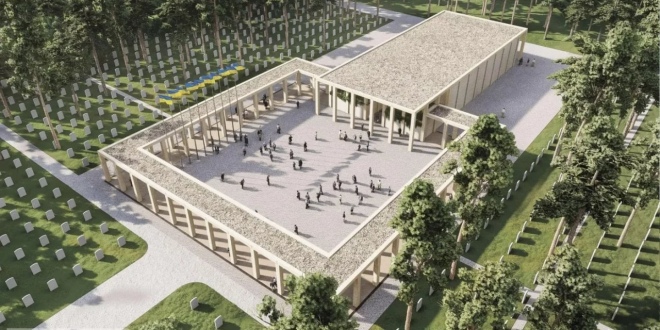

On August 1, the state institution National Military Memorial Cemetery awarded a participant in the procurement of the first stage of the complex construction. Building UA consortium is to receive orders for almost UAH 1.8 billion. This news caused indignation among the public because the consortium was created the day after the procurement had been announced. However, the duration of the potential contractor’s existence is not the biggest problem. DOZORRO experts analyzed the procurement transaction and found that the awarded consortium was probably related to the designer.
Participants in the consortium
The consortium was established on July 4, 2024, the day after the procurement had been announced. This is not a purely new company, but an association of experienced companies. The founders are:
- 80% of EUROELITBUD LLC from Odesa;
- 10% of PJSC Brovarske Road Construction Department No. 50 from Brovary;
- 10% of AKAM LLC from Dnipro.
The ultimate beneficiaries of the consortium are Oleksandr Isayev and Natalia Poberezhets, with equal shares of 40%; they equally own the corporate rights of EUROELITBUD LLC, the majority founder of the association. Serhii Saushyn, director of EUROELITBUD LLC, was appointed as the head.
Despite the central role in the management of the consortium, EUROELITBUD LLC has previously been awarded only in two procurement transactions, and only one of them was related to construction—the arrangement of a shelter in a hospital in the Kyiv Region for UAH 28 million.
Other participants are more experienced:
- PJSC Brovarske BRCD No. 50 has participated in 820 tenders since 2016, and the total amount under the contracts is more than UAH 3.5 billion;
- AKAM LLC was awarded contracts worth almost a billion hryvnias, mainly contracts for the supply of modular shelters in the Dnipropetrovsk, Donetsk, and Kyiv regions.
“It is not surprising that the group of companies saw some requirements for participation in the construction project of the National Military Memorial Cemetery… communicated with its colleagues, realized what experience they could provide in this consortium, and after the announcement of the requirements, created the association. This is not something new; there are many precedents and successful cases,” Censor.NET quotes Yaroslav Starushchenko, deputy director of the National Military Memorial Cemetery, from the briefing on August 2.
The companies included in the consortium have existed for quite a long time—from 10 to 30 years. And in general, combining firms for a large order is really a common practice. However, the quick way in which they did it arouses suspicions. The procuring entity announced the procurement transactions on July 3 at 8:17 p.m. Even if the companies saw it immediately after the announcement, they had about 24 hours to:
- assess the requirements for the contractor and decide to participate in the tender;
- find partners, agree on the merger, capacity, and risks of fulfilling the future agreement, agree on the ownership and management structure, and discuss the distribution of profits;
- prepare all the necessary documents, submit them to the notary, who is the state registrar, and gather in one location for signing.
“It is difficult to imagine such efficiency in practice. This leads to the idea that companies probably knew about the tender and its requirements in advance,” says Yaroslav Pylypenko, public procurement monitoring specialist at TI Ukraine.
Designer and contractor having the same name
In late 2023, the procuring entity held a tender for the development of design documentation for the first stage of the object. It was attended by 3 participants. The lowest bid was rejected because it did not contain the object inspection report signed by the procuring entity. This requirement is overall discriminatory because the procuring entity can sign the document only for selected participants. This is also a way to meet with representatives of project organizations before the auction. The rejected participant appealed to the AMCU, but did so in regard to the decision of the procuring entity, and not the conditions of the tender, so the appeal was unsuccessful. Odesa-based PE TERRA ENGINEERING was awarded in the procurement transaction.
According to YouControl, Valentyn Viktorovych Yevdokymenko has been the director of PE TERRA ENGINEERING since March 2017. A person with the same full name was the director of EUROELITBUD LLC from May 2019 to February 2024—a member of the consortium with the most significant contribution to the authorized capital. That is, EUROELITBUD LLC probably had the same director as PE TERRA ENGINEERING, which at that time was developing a construction project.
In August, PE TERRA ENGINEERING was awarded a contract for the development of the 2nd stage of the National Military Memorial Cemetery project for UAH 29 million.
Requirement to have an anti-corruption certificate
Only one participant submitted a proposal to procure construction of the first stage of the cemetery. This is a common situation: this year, only one bid accounted for 90% of the construction lots. We were interested in the requirement, among other certificates, to have an ISO Anti-bribery management systems—Requirements with guidance for use. Its necessity in this case raises questions.
At first, the tender documentation required the participant to provide a bank guarantee for their tender bid in the amount of UAH 9 million. However, on July 15, the procuring entity removed this condition.
Overall, the remaining requirements are acceptable for such a scope of work.
The procuring entity also made changes to the file with the list of resources required to perform the works. At first, it accidentally published the list with prices for materials, but then re-uploaded the document without them. Interestingly, the prices for construction materials, which were first published by the procuring entity, are the same as the prices in the awarded participant’s documents. The current price, shipping and storage costs, and even comment columns are identical.
Prices for identifiable building materials are market-based in general, and we have not found any significant overpayments so far. However, since the price in the contract is dynamic, the cost of resources can increase in the process of its implementation.






